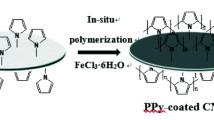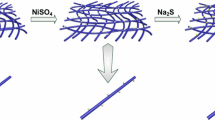Abstract
A freestanding, binder-free flexible polypyrrole: polystyrene sulfonate/cellulose nanopaper (PPy:PSS/CNP) electrode is successfully fabricated by a low-cost, simple, and fast vacuum filtration method for the first time. The hierarchical structure of CNP with high surface area and good mechanical strength not only provides a high electroactive region and shortens the diffusion distance of electrolyte ions, but also mitigates the volumetric expansion/shrinkage of the PPy during the charging/discharging process. The optimized PPy:PSS/CNP exhibits a high areal specific capacitance of 3.8 F cm−2 (corresponding to 475 F cm−3 and 240 F g−1) at 10 mV s−1 and good cycling stability (80.9% capacitance retention after 5000 cycles). The cyclic voltammetry curves of PPy:PSS/CNP at different bending angles indicate prominent flexibility and electrochemical stability of the electrode. Moreover, a symmetric supercapacitor device is assembled and delivers a high areal energy density of 122 µ cm−2 (15 W h cm−3) at a power density of 4.4 mW cm−2 (550 mW cm−3), which is superior to other cellulose-based materials. The combination of high supercapacitive performance, flexibility, easy fabrication, and cheapness of the PPy: PSS/CNP electrodes offers great potential for developing the next generation of green and economical portable and wearable consumer electronics.

摘要
本工作通过低成本、 简单、 快速的真空过滤方法首次成功制备了一种独立的、 无粘合剂的柔性聚吡咯:聚磺苯乙烯/纤维素纳米纸电极(PPy:PSS/CNP). 多层结构的纤维素纳米纸具有较高的表面积和良好的机械强度, 不仅提供了高的电活性区域, 缩短了电解质离子的扩散距离, 而且还阻止了PPy在充电/放电过程中的体积膨胀/收缩. 优化后的PPy:PSS/CNP在10 mV s−1时表现出3.8 F cm−2(对应于475 F cm−3和240 F g−1)的高比电容和良好的循环稳定性(在5000次循环后有80.9%的电容保持率). PPy:PSS/CNP在不同弯曲角度下的循环伏安曲线表明电极具有突出的柔韧性和电化学稳定性. 此外, 组装的对称超级电容器器件在功率密度为4.4 mW cm−2(550 mW cm−3)的情况下, 提供了122 µW h cm−2(15 W h cm−3)的高面积能量密度, 这个值优于其他基于纤维素电极材料制备的器件. PPy:PSS/CNP电极结合了高电容性能、 灵活性、 易于制造和廉价多个优势, 为开发下一代绿色、经济便携式和可穿戴电子产品提供了巨大潜力.
Similar content being viewed by others
References
Poonam, Sharma K, Arora A, et al. Review of supercapacitors: Materials and devices. J Energy Storage, 2019, 21: 801–825
Wang G, Zhang L, Zhang J. A review of electrode materials for electrochemical supercapacitors. Chem Soc Rev, 2012, 41: 797–828
Wang Y, Wu X, Han Y, et al. Flexible supercapacitor: Overview and outlooks. J Energy Storage, 2021, 42: 103053
Chee WK, Lim HN, Zainal Z, et al. Flexible graphene-based supercapacitors: A review. J Phys Chem C, 2016, 120: 4153–4172
Hillier N, Yong S, Beeby S. The good, the bad and the porous: A review of carbonaceous materials for flexible supercapacitor applications. Energy Rep, 2020, 6: 148–156
Huang Y, Li H, Wang Z, et al. Nanostructured polypyrrole as a flexible electrode material of supercapacitor. Nano Energy, 2016, 22: 422–438
Yi TF, Qiu LY, Mei J, et al. Porous spherical NiO@NiMoO4@PPy nanoarchitectures as advanced electrochemical pseudocapacitor materials. Sci Bull, 2020, 65: 546–556
Fu H, Du Z, Zou W, et al. Carbon nanotube reinforced polypyrrole nanowire network as a high-performance supercapacitor electrode. J Mater Chem A, 2013, 1: 14943
Qian T, Yu C, Wu S, et al. A facilely prepared polypyrrole-reduced graphene oxide composite with a crumpled surface for high performance supercapacitor electrodes. J Mater Chem A, 2013, 1: 6539
Gahlout P, Choudhary V. Tailoring of polypyrrole backbone by optimizing synthesis parameters for efficient EMI shielding properties in X-band (8.2–12.4 GHz). Synth Met, 2016, 222: 170–179
Huang YM, Zhou F, Deng Y, et al. Effects of salt 9,10-anthraquinone-2-sulfonic acid sodium on the conductivity of polypyrrole. Solid State Ion, 2008, 179: 1305–1309
Wang W, Li Z, Jiang T, et al. Sulfonated poly(ether ether ketone)/polypyrrole core-shell nanofibers: A novel polymeric adsorbent/conducting polymer nanostructures for ultrasensitive gas sensors. ACS Appl Mater Interfaces, 2012, 4: 6080–6084
Malik RS, Tripathi SN, Gupta D, et al. Novel anhydrous composite membranes based on sulfonated poly(ether ketone) and aprotic ionic liquids for high temperature polymer electrolyte membranes for fuel cell applications. Int J Hydrogen Energy, 2014, 39: 12826–12834
Ouyang J, Chu CW, Chen FC, et al. High-conductivity poly(3,4-ethylenedioxythiophene):poly(styrene sulfonate) film and its application in polymer optoelectronic devices. Adv Funct Mater, 2005, 15: 203–208
Maruthamuthu S, Chandrasekaran J, Manoharan D, et al. Conductivity and dielectric analysis of nanocolloidal polypyrrole particles functionalized with higher weight percentage of poly(styrene sulfonate) using the dispersion polymerization method. J Polym Eng, 2017, 37: 481–492
Miao C, Du H, Zhang X, et al. Dynamic crack initiation and growth in cellulose nanopaper. Cellulose, 2021, 29: 557–569
Liu H, Du H, Zheng T, et al. Cellulose based composite foams and aerogels for advanced energy storage devices. Chem Eng J, 2021, 426: 130817
Zhao D, Zhang Q, Chen W, et al. Highly flexible and conductive cellulose-mediated PEDOT:PSS/MWCNT composite films for supercapacitor electrodes. ACS Appl Mater Interfaces, 2017, 9: 13213–13222
Jyothibasu JP, Kuo DW, Lee RH. Flexible and freestanding electrodes based on polypyrrole/carbon nanotube/cellulose composites for supercapacitor application. Cellulose, 2019, 26: 4495–4513
Du H, Zhang M, Liu K, et al. Conductive PEDOT:PSS/cellulose nanofibril paper electrodes for flexible supercapacitors with superior areal capacitance and cycling stability. Chem Eng J, 2022, 428: 131994
Parit M, Du H, Zhang X, et al. Polypyrrole and cellulose nanofiber based composite films with improved physical and electrical properties for electromagnetic shielding applications. Carbohydrate Polyms, 2020, 240: 116304
Li S, Shi Q, Li Y, et al. Intercalation of metal ions into Ti3C2Tx MXene electrodes for high-areal-capacitance microsupercapacitors with neutral multivalent electrolytes. Adv Funct Mater, 2020, 30: 2003721
Wan C, Jiao Y, Li J. Flexible, highly conductive, and free-standing reduced graphene oxide/polypyrrole/cellulose hybrid papers for supercapacitor electrodes. J Mater Chem A, 2017, 5: 3819–3831
Maruthamuthu S, Chandrasekaran J, Manoharan D, et al. Effect of CuBr2 salt treatment on the performance of nanocolloidal PPy:PSS multilayer thin film counter electrodes of dye-sensitized solar cells. J Appl Polym Sci, 2016, 133: 43114
Lay M, Pèlach MÀ, Pellicer N, et al. Smart nanopaper based on cellulose nanofibers with hybrid PEDOT:PSS/polypyrrole for energy storage devices. Carbohydrate Polyms, 2017, 165: 86–95
Fei X, Wang J, Zhu J, et al. Biobased poly(ethylene 2,5-furancoate): No longer an alternative, but an irreplaceable polyester in the polymer industry. ACS Sustain Chem Eng, 2020, 8: 8471–8485
Fei G, Wang Y, Wang H, et al. Fabrication of bacterial cellulose/polyaniline nanocomposite paper with excellent conductivity, strength, and flexibility. ACS Sustain Chem Eng, 2019, 7: 8215–8225
Li Y, Zhang H, Ni S, et al. In situ synthesis of conductive nanocrystal cellulose/polypyrrole composite hydrogel based on semi-interpenetrating network. Mater Lett, 2018, 232: 175–178
Kashani H, Chen L, Ito Y, et al. Bicontinuous nanotubular graphene-polypyrrole hybrid for high performance flexible supercapacitors. Nano Energy, 2016, 19: 391–400
Zhang J, Chen P, Oh BHL, et al. High capacitive performance of flexible and binder-free graphene-polypyrrole composite membrane based on in situ reduction of graphene oxide and self-assembly. Nanoscale, 2013, 5: 9860–9866
Guan X, Pan L, Fan Z. Flexible, transparent and highly conductive polymer film electrodes for all-solid-state transparent supercapacitor applications. Membranes, 2021, 11: 788
Du H, Parit M, Liu K, et al. Engineering cellulose nanopaper with water resistant, antibacterial, and improved barrier properties by impregnation of chitosan and the followed halogenation. Carbohydrate Polyms, 2021, 270: 118372
Miao F, Shao C, Li X, et al. Electrospun carbon nanofibers/carbon nanotubes/polyaniline ternary composites with enhanced electrochemical performance for flexible solid-state supercapacitors. ACS Sustain Chem Eng, 2016, 4: 1689–1696
Xia L, Li X, Wu Y, et al. Electrodes derived from carbon fiber-reinforced cellulose nanofiber/multiwalled carbon nanotube hybrid aerogels for high-energy flexible asymmetric supercapacitors. Chem Eng J, 2020, 379: 122325
Hou M, Xu M, Hu Y, et al. Nanocellulose incorporated graphene/polypyrrole film with a sandwich-like architecture for preparing flexible supercapacitor electrodes. Electrochim Acta, 2019, 313: 245–254
Olsson H, Nyström G, Strømme M, et al. Cycling stability and self-protective properties of a paper-based polypyrrole energy storage device. Electrochem Commun, 2011, 13: 869–871
Koga H, Tonomura H, Nogi M, et al. Fast, scalable, and eco-friendly fabrication of an energy storage paper electrode. Green Chem, 2016, 18: 1117–1124
Anothumakkool B, Soni R, Bhange SN, et al. Novel scalable synthesis of highly conducting and robust PEDOT paper for a high performance flexible solid supercapacitor. Energy Environ Sci, 2015, 8: 1339–1347
Wang T, Zhang W, Yang S, et al. Preparation of foam-like network structure of polypyrrole/graphene composite particles based on cellulose nanofibrils as electrode material. ACS Omega, 2020, 5: 4778–4786
Fu Q, Wang Y, Liang S, et al. High-performance flexible freestanding polypyrrole-coated CNF film electrodes for all-solid-state super-capacitors. J Solid State Electrochem, 2020, 24: 533–544
Li B, Lopez-Beltran H, Siu C, et al. Vaper phase polymerized PEDOT/cellulose paper composite for flexible solid-state supercapacitor. ACS Appl Energy Mater, 2020, 3: 1559–1568
Gao K, Shao Z, Wang X, et al. Cellulose nanofibers/multi-walled carbon nanotube nanohybrid aerogel for all-solid-state flexible supercapacitors. RSC Adv, 2013, 3: 15058
Lyu S, Chen Y, Zhang L, et al. Nanocellulose supported hierarchical structured polyaniline/nanocarbon nanocomposite electrode via layer-by-layer assembly for green flexible supercapacitors. RSC Adv, 2019, 9: 17824–17834
Zheng Q, Cai Z, Ma Z, et al. Cellulose nanofibril/reduced graphene oxide/carbon nanotube hybrid aerogels for highly flexible and all-solidstate supercapacitors. ACS Appl Mater Interfaces, 2015, 7: 3263–3271
Zou Z, Zhou W, Zhang Y, et al. High-performance flexible all-solidstate supercapacitor constructed by free-standing cellulose/reduced graphene oxide/silver nanoparticles composite film. Chem Eng J, 2019, 357: 45–55
Liu R, Ma L, Huang S, et al. A flexible polyaniline/graphene/bacterial cellulose supercapacitor electrode. New J Chem, 2017, 41: 857–864
Wang W, Yang Y, Chen Z, et al. High-performance yarn supercapacitor based on directly twisted carbon nanotube@bacterial cellulose membrane. Cellulose, 2020, 27: 7649–7661
Bai Y, Liu R, Li E, et al. Graphene/carbon nanotube/bacterial cellulose assisted supporting for polypyrrole towards flexible supercapacitor applications. J Alloys Compd, 2019, 777: 524–530
Ma L, Liu R, Niu H, et al. Flexible and freestanding electrode based on polypyrrole/graphene/bacterial cellulose paper for supercapacitor. Compos Sci Tech, 2016, 137: 87–93
Acknowledgements
This work was partially supported by the National Science Foundation (CMMI-2113948). Liang Y acknowledges the financial support from China Scholarship Council (201708510080).
Author information
Authors and Affiliations
Contributions
Author contributions Zhang X conceived the idea. Liang Y designed and performed the experiments with the help from Wang HE. Wei Z performed the SEM test. Liang Y analyzed the data and drafted the manuscript. Zhang X and Wang R supervised the whole research. All authors participated in the general discussion.
Corresponding authors
Ethics declarations
Conflict of interest The authors declare that they have no conflict of interest.
Additional information
Supplementary information Supporting data are available in the online version of the paper.
Yue Liang received her master’s degree from China West Normal University in June 2017. Since 2018, she has been studying as a doctoral candidate in the group of Prof. Xinyu Zhang at the Department of Chemical Engineering, Auburn University. Her research interests mainly focus on microwave-initiated ultrafast nanomanufacturing for hierarchical, multifunctional nanomaterials and nanocomposites, and the fabrication of flexible electrodes based on conducting polymers.
Ruigang Wang received his doctorate with Prof. Peter Crozier and Dr. Renu Sharma in materials science and engineering from Arizona State University in 2007. In August 2016, he joined the Department of Metallurgical and Materials Engineering, The University of Alabama as an associate professor. His research mainly focuses on shape/size-controlled synthesis of metal oxides, emission control catalysts, support structure effect in metal-oxide catalysis, materials for energy capture, storage and conversion, metal recycling, and high temperature ceramics processing.
Xinyu Zhang received his doctorate with Prof. Alan G. MacDiarmid and Dr. Sanjeev K. Manohar in materials chemistry from the University of Texas at Dallas in 2005. He is a professor in chemical engineering at Auburn University and his research mainly focuses on microwave-initiated ultrafast nanomanufacturing for hierarchical, multifunctional nanomaterials and nanocomposites, multifunctional polymer coating for anti-corrosion and antimicrobial applications, and green approach to conducting polymer-based nanocomposites for catalysis, sensing and energy storage applications.
Supporting information
40843_2022_2225_MOESM1_ESM.pdf
Flexible freestanding conductive nanopaper based on PPy:PSS nanocellulose composite for supercapacitors with high performance
Rights and permissions
About this article
Cite this article
Liang, Y., Wei, Z., Wang, HE. et al. Flexible freestanding conductive nanopaper based on PPy:PSS nanocellulose composite for supercapacitors with high performance. Sci. China Mater. 66, 964–973 (2023). https://doi.org/10.1007/s40843-022-2225-x
Received:
Accepted:
Published:
Issue Date:
DOI: https://doi.org/10.1007/s40843-022-2225-x




